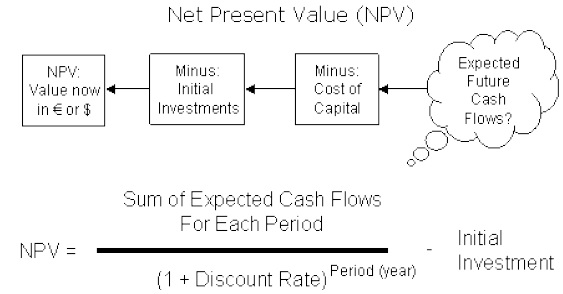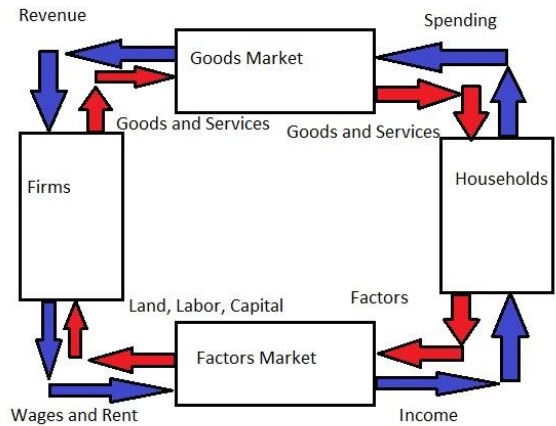Investment Under Certainty
Capital Budgeting is the process by which the firm decides which long-term investments to make. Capital Budgeting projects, i.e., potential long-term investments, are expected to generate cash flows over several years.
Capital Budgeting also explains the decisions in which all the incomes and expenditures are covered. These decisions involve all inflows and outflows of funds of an undertaking for a particular period of time.
Capital Budgeting techniques under certainty can be divided into the following two groups −
Non Discounted Cash Flow
- Pay Back Period
- Accounting Rate of Return (ARR)
Discounted Cash Flow
- Net Present Value (NPV)
- Profitability Index (PI)
- Internal Rate of Return (IRR)
The payback period (PBP) is the traditional method of capital budgeting. It is the simplest and perhaps the most widely used quantitative method for appraising capital expenditure decision; i.e. it is the number of years required to recover the original cash outlay invested in a project.
Non-Discounted Cash Flow
Non-discounted cash flow techniques are also known as traditional techniques.
Pay Back Period
Payback period is one of the traditional methods of budgeting. It is widely used as quantitative method and is the simplest method in capital expenditure decision. Payback period helps in analyzing the number of years required to recover the original cash outlay invested in a particular project. The formula widely used to calculate payback period is −
PBP =
Initial InvestmentConstant annual cash inflow
Advantages of Using PBP
PBP is a cost effective and easy to calculate method. It is simple to use and does not require much of the time for calculation. It is more helpful for short term earnings.
Accounting Rate of Return (ARR)
The ARR is the ratio after tax profit divided by the average investment. ARR is also known as return on investment method (ROI). Following formula is usually used to calculate ARR −
ARR =
Average annual profit after taxAverage investment
×
100
The average profits after tax are obtained by adding up the profit after tax for each year and dividing the result by the number of years.
Advantages of Using ARR
ARR is simple to use and as it is based on accounting information, it is easily available. ARR is usually used as a performance evaluation measure and not as a decision making tool as it does not use cash flow information.
Discounted Cash Flow Techniques
Discounted cash flow techniques consider time value of money and are therefore also known as modern techniques.
Net Present Value (NPV)
The net present value is one of the discounted cash flow techniques. It is the difference between the present value of future cash inflows and the present value of the initial outlay, discounted at the firm’s cost of capital. It recognizes the cash flow streams at different time intervals and can be computed only when they are expressed in terms of common denominator (present value). Present value is calculated by determining an appropriate discount rate. NPV is calculated with the help of equation.
NPV = Present value of cash inflows − Initial investment.

Advantages
NPV is considered as the most appropriate measure of profitability. It considers all the years of cash flow, and recognizes the time value for money. It is an absolute measure of profitability that means it gives output in terms of absolute amount. The NPVs of the projects can be added together which is not possible in other methods.
Profitability Index (PI)
Profitability index method is also known as benefit cost ratio as numerator measures benefits and denominator measures cost like the NPV approach. It is the ratio obtained by dividing the present value of future cash inflows by the present value of cash outlays. Mathematically it is defined as −
PI =
Present value of cash inflowInitial cash outlay
Advantages
In a capital rationing situation, PI is a better evaluation method as compared to NPV method. It considers the time value of money along cash flows generated by the project.
| Present Cash Value | |||
|---|---|---|---|
| Year | Cash Flows | @ 5% Discount | @ 10% Discount |
| 0 | $ -10,000.00 | $ -10,000.00 | $ -10,000.00 |
| 1 | $ 2,000.00 | $ 1,905.00 | $ 1,818.00 |
| 2 | $ 2,000.00 | $ 1,814.00 | $ 1,653.00 |
| 3 | $ 2,000.00 | $ 1,728.00 | $ 1,503.00 |
| 4 | $ 2,000.00 | $ 1,645.00 | $ 1,366.00 |
| 5 | $ 5,000.00 | $ 3,918.00 | $ 3,105.00 |
| Total | $ 1,010.00 | $ -555.00 | |
Profitability Index (5%) =
$11010$10000
= 1.101
Profitability Index (10%) =
$9445$10000
= .9445Internal Rate of Return (IRR)
Internal rate of return is also known as yield on investment. IRR depends entirely on the initial outlay of the projects which are evaluated. It is the compound annual rate of return that the firm earns, if it invests in the project and receives the given cash inflows. Mathematically IRR is determined by the following equation −
IRR = T∑t=1
Ct(1 + r)t
− 1c0
Where,
R = The internal rate of return
Ct = Cash inflows at t period
C0 = Initial investment
Example −
| Internal Rate of Return | |
|---|---|
| Opening Balance | -100,000 |
| Year 1 Cash Flow | 110000 |
| Year 2 Cash Flow | 113000 |
| Year 3 Cash Flow | 117000 |
| Year 4 Cash Flow | 120000 |
| Year 5 Cash Flow | 122000 |
| Proceeds from Sale | 1100000 |
| IRR | 9.14% |
Advantages
IRR considers the total cash flows generated by a project over the life of the project. It measures profitability of the projects in percentage and can be easily compared with the opportunity cost of capital. It also considers the time value of money.
Circular Flow Model of Economy
Circular flow model is the basic economic model and it describes the flow of money and products throughout the economy in a very simplified manner. This model divides the market into two categories −
- Market of goods and services
- Market for factor of production
The circular flow diagram displays the relationship of resources and money between firms and households. Every adult individual understands its basic structure from personal experience. Firms employ workers, who spend their income on goods produced by the firms. This money is then used to compensate the workers and buy raw materials to make the goods. This is the basic structure behind the circular flow diagram. Let’s have a look at the following diagram −

In the above model, we can see that the firms and the households interact with each other in both product market as well as factor of production market. The product market is the market where all the products by the firms are exchanged and factors of production market is where inputs such as land, labor, capital and resources are exchanged. Households sell their resources to the businesses in the factor market to earn money. The prices of the resources, the businesses purchase are “costs”. Business produces goods utilizing the resources provided by the households, which are then sold in the product market. Households use their incomes to purchase these goods in the product market. In return for the goods, businesses bring in revenue.
Inflation
In economics, inflation means rise in the general level of prices of goods and services over a period of time in an economy. Inflation may affect the economy either in positive way or negative way.
Causes of Inflation
The causes of inflation are as follows −
- Inflation may occur sometimes due to excessive bank credit or currency depreciation.
- It may be caused due to increase in demand in relation to supply of all types goods and services due to a rapid increase in population.
- Inflation also may be also be caused by a change in the value of production costs of goods.
- Export boom inflation also comes into existence when a considerable increase in exports may cause a shortage in the home country.
Inflation is also caused by decrease in supplies, consumer confidence, and corporate decisions to charge more.
Measures to Control Inflation
There are many ways of controlling inflation in an economy −
Monetary Measure
The most important method of controlling inflation is monetary policy of the Central Bank. Most central banks use high interest rates as a way to fight inflation. Following are the monetary measures used to control inflation −
- Bank Rate Policy − Bank rate policy is the most common tool against inflation. The increase in bank rate increases the cost of borrowings which reduces commercial banks borrowing from the central bank.
- Cash Reserve Ratio − To control inflation, the central bank needs to raise CRR which helps in reducing the lending capacity of the commercial banks.
- Open Market Operations − Open market operations mean the sale and purchase of government securities and bonds by the central bank.
Fiscal Policy
Fiscal measures are another important set of measures to control inflation which include taxation, public borrowings, and government expenses. Some of the fiscal measures to control inflation are as follows −
- Increase in savings
- Increase in taxes
- Surplus budgets
Wage and Price Controls
Wage and price controls help in controlling wages as the price increases. Price control and wage control is a short term measure but is successful; since in long run, it controls inflation along with rationing.
Impact of Inflation on Managerial Decision Making
Inflation is of course the all too familiar problem of too much money (demand) chasing too few goods (supply), with the upshot of prices and expectations everywhere tending to rise higher and higher.
The Role of a Manager
In these circumstance, a business manager has to take appropriate decisions and measures based on macro economic uncertainties like inflation and the occasional recession.
A true test of a business manager lies in delivering profitability ie., the extent to which he increases revenues and also reduces costs even during economic uncertainties.
In the current scenario, they are supposed to get faster solutions to the problems of coping with soaring prices (for example) by understanding the process of how inflation distorts the traditional functions of money along with recommendations.
The Effect of Management
The bottom-line impact is that, Customers / clients reward efficient management with profits and penalize inefficient management with losses. Hence, it is advisable to be well prepared to tackle these areas.